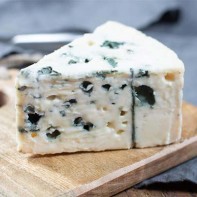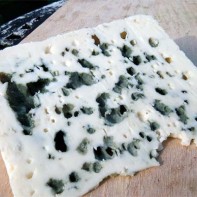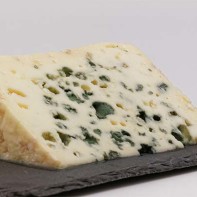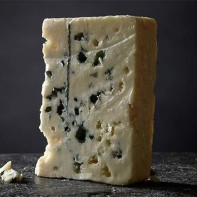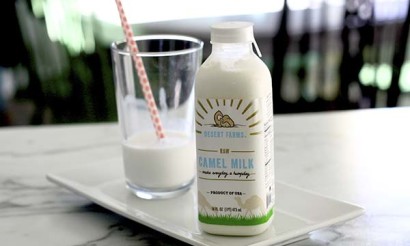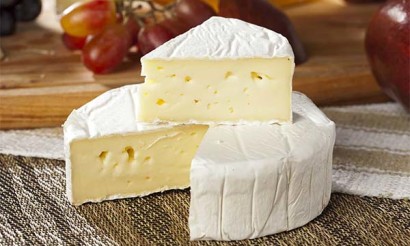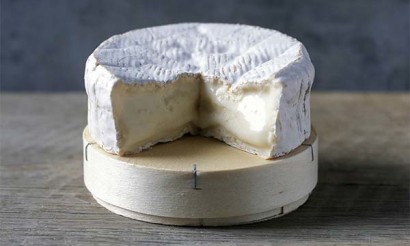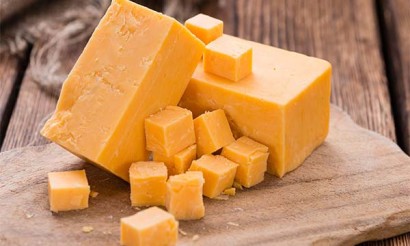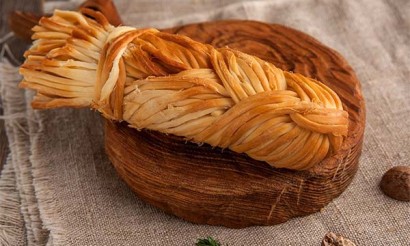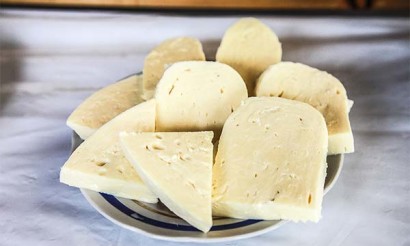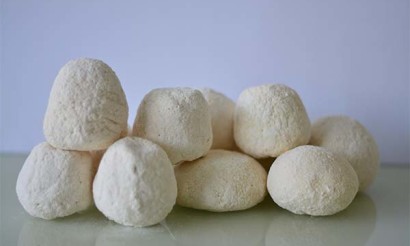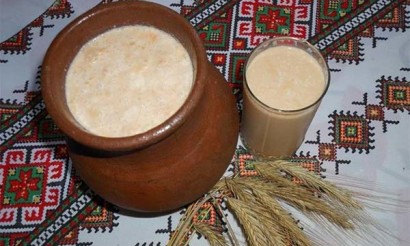Roquefort (blue mold cheese): composition, benefits and harms, recipes
Roquefort (Roquefort) is deservedly considered the king of cheeses. In France, it is called the dish of kings and popes. Foodies around the world highly appreciate its amazing nutty taste.
- Roquefort: what kind of cheese is it, what does it taste like and what does it smell like?
- History of origin
- Production technology
- What it tastes like?
- What it smells like?
- What makes Roquefort different from other cheeses?
- From Dor Blue
- From gorgonzola
- Composition and calories
- Benefits of Roquefort cheese
- Harm and contraindications
- How to choose and store properly
- How and with what Roquefort is eaten
- What wine to go with Roquefort
- Where to buy and how much costs
- How to cook Roquefort at home
- Roquefort Recipes
- Unusual pumpkin quiche with Roquefort
- Roquefort Salad
- What to replace Roquefort cheese in a recipe
- Interesting Facts
Roquefort: what kind of cheese is it, what does it taste like and what does it smell like?
Roquefort cheese is one of the blue varieties with mold, produced in France. It is made in the southern province of Rouergue near the village of Roquefort. It is the village that gave the product its name. The flesh is slightly moist and crumbly with blue-green or even greyish streaks of the mould Penicillium roqueforti. It is considered noble because it differs from other species in its beneficial effects on the human body. The handmade product is characterized by an uneven distribution of mold inside.
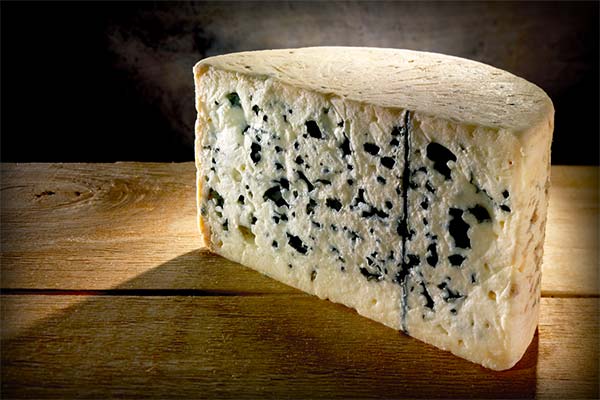
The head of cheese has no crust. It matures in a special package in which it is later sold. This not only prevents the product from drying out, but also at a certain stage prevents excessive development of mold. Usually, the head of Roquefort has a cylindrical shape with a diameter of 19-20 centimeters and weighs a little more than 2,5 kilograms. The packaging of real cheese bears the inscription "Protected Designation of Origin Roquefort".
History of Origin
There is an interesting legend about the origin of Roquefort cheese among the French.
According to the story of the inhabitants of the Rouergue province, a long time ago a young boy, grazing sheep on the slopes not far from the village of Roquefort, decided to have a snack in one of the caves. His food was simple. Just bread, cheese and water. Before he had even begun his meal, he noticed a girl passing by and rushed after her. For weeks he pursued the beautiful stranger, but could not catch up with her. When he came back with nothing, he found a bluish mold extending from the bread to the cheese. But his hunger was so strong that he risked tasting a small piece. To the young man's amazement, its delicate and brackish flavor was so amazing that he brought the leftovers back to the village to try. The locals also began to take the cheese and bread to the caves, of which there were many in the area. Thus, according to legend, Roquefort was born.
Modern scientists are inclined to believe that the appearance of cheese with mold, the spores of which can be eaten, is a perfect accident.
Despite the fact that the blue cheese is considered later compared to other dairy products, the first mention of them occurs in the writings of the ancient Roman polymath Pliny the Elder, who died in 79 AD.
In 1411. In 1411 Charles VI by a special rescript granted the inhabitants of the village of Roquefort the exclusive right to produce cheese of the same name.
Now, according to the rules of protection of EU geographical indications, Roquefort cheese ripens exclusively in the grottos around the village of Roquefort in France. Seven companies are involved in its production. The largest of them is Societe des Caves de Roquefort. It produces about 60% of the total production and owns several caves. They are the ones who organize excursions to the local cheeses.
Production technology
The classic recipe involves sheep's milk as the basis. At the beginning of XX century there were attempts to replace it with cow's milk. But it spoiled the final taste of the product. Therefore, the manufacturers have not experimented further and returned to the familiar method of production.
In order to get a real Roquefort cheese, milk is taken only from sheep of the Laconia breed, which are pastured in the local valleys. According to the standard, after milking, it must go to processing within two days. If this period has expired, then you can not get good quality cheese.
The milk is heated to about +30 ° C so that it curdles. It is added to milk enzymes, gasifiers, fungal spores Penicillium roqueforti. The finished curd mass is mixed, cut, without pressing poured into molds and salted with dry salt.
Before placing the cheese to mature it is "pricked". The mass is pierced with special spokes. This is necessary to allow air to enter, so that the mold can develop. This procedure is performed at least two days before ripening.
The further process takes place in a geographically limited space: in the caves of the Combalou valley, which are only 2 km long and 300 m wide. The air temperature and humidity, which remains unchanged in the natural cavities, make it possible to create a quality product.
Maturation in natural cellars takes place in wooden or plastic containers for two weeks. After that the future cheese is wrapped in a special foil package. This helps to regulate the development of Penicillium roqueforti spores. Further ripening lasts at least 60-90 days. If you do not make it through that time, it will ruin your product's taste.
Modern technology allows you to slow down the process of maturation of cheese, which allows you to saturate the market with this delicious product all year round.
How it tastes
Roquefort's popularity is due to its extraordinary multi-layered flavor, which is particularly appreciated by gourmets around the world. At first it may seem slightly sweet and buttery, then a nutty flavor begins to be felt. After that the sharp veins of blue mold come out in full force.
What it smells like
Opinions about what real Roquefort cheese smells like vary dramatically. Some believe it has the natural aroma of sheep's milk with a hint of limestone. Some catch a hint of peanut in its smell. And some refer this French delicacy to the stinkiest cheeses in the world, capturing in it only rotten smell. One thing's for sure: this flavor is unmistakable.
How Roquefort differs from other cheeses
Similar blue varieties are made in different countries. But the European legislation enshrined the name Roquefort only for the product made in the commune of Roquefort-sur-Soulson.
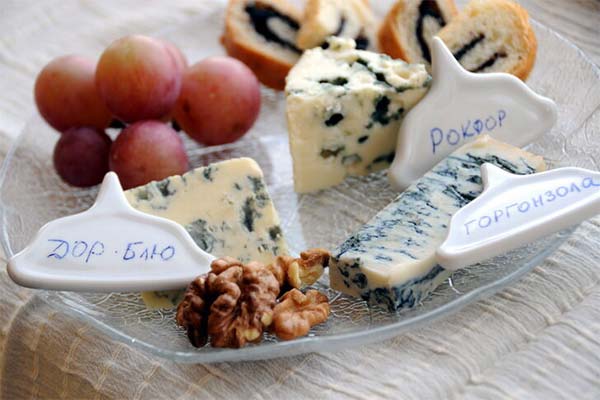
This cheese has no crust, has a buttery, creamy consistency with eyelets filled with green-blue mold. In high-end restaurants, in order not to damage the Penicillium roqueforti structure, a special roqueforti slicer is used to cut the product.
From Dor Blue.
Dor Blue, like Roquefort, refers to blue cheeses. But those who have tasted them once will never confuse the two products. Despite the fact that the German product is the youngest among other cheeses of this type, it has already found its fans. It is produced by the famous German company "Kezerai Champignon Hofmeister". Dor Blue is more affordable than its French predecessor.
The flavor palette of this cheese varies from grassy to fruity. Depending on the variety it can have different consistency. For example, A la Creme is pasty, Classic is aged in the usual semi-hard manner, and Grand noir is the only blue variety with a fat content of 60%.
For those who dare to try mold cheese for the first time, experts advise to start with Dor Blue.
From gorgonzola
This Italian product is made from cow's milk, using the fungus penicillium glaucum. The cheese differs from roquefort with a whiter color with a soft yellowish hue. The mold is located on it non-uniformly, with characteristic fungal streaks. Young dolce has a pasty structure. It is very sweet. The more aged piccante is noticeably denser.
The smell of this cheese on the one hand is more "coarse" than that of Roquefort, but on the other hand it is not so pronounced.
Composition and calories
Roquefort cheese in its composition practically does not contain lactose. Its caloric value is quite high: 335 kcal per 100 grams of product, which is about 1/5 of the daily norm for an adult. But the rich chemical composition of the product makes it a valuable meal.
One hundred grams of the edible part contains:
Vitamins:
- A (retinol) - 278 mcg;
- B1 (thiamine) - 0.03 mg;
- B2 (riboflavin) - 0.4 mg;
- B3 (nicotinic acid) - 5.7 mg;
- B5 (calcium pantothenate) - 1.16 mg;
- B6 (pyridoxine) - 0.15 mg;
- B7 (coenzyme R) - 4.2 µg;
- B9 (folic acid) - 39 µg;
- B12 (cobalamin) - 0.62 µg;
- C (ascorbic acid) - 0.6 mg;
- D (viosterol, ergosterol) - 0.89 µg;
- E (tocopherol) - 0.4 mg.
Macronutrients:
- Potassium, K - 110 mg;
- calcium, Ca - 740 mg;
- magnesium, Mg - 40 mg;
- sodium, Na - 1300 mg;
- sulfur, S - 205 mg;
- phosphorus, P - 410 mg;
- Chlorine, Cl - 2004 mg.
Micronutrients:
- iron, fe - 1 mg;
- manganese, mn - 0.03 mg;
- copper, cu - 60 mg;
- selenium, se - 14.5 ug;
- zinc, zn - 3.5 mg.
Essential amino acids:
- arginine - 0.79 g;
- valine - 1.08 gr.
- histidine - 1,28 gr;
- Isoleucine - 0.88 gr;
- Leucine - 1,52 gr;
- lysine - 1.36 gr;
- methionine - 0,53 gr;
- methionine + cysteine - 0.68 gr;
- threonine - 0,8 gr;
- tryptophan - 0,9 gr;
- phenylalanine - 1.05 gr;
- Phenylalanine + Tyrosine - 2.25 g.
Substitutable amino acids:
- Alanine - 0.55 g;
- Aspartic acid - 1.22 gr;
- Glycine - 0.35 gr.
- Glutamic acid - 4.06 gr;
- proline - 1.89 gr;
- serine - 1.16 gr;
- tyrosine - 1.205 g;
- cysteine - 0.15 g.
- sterols (sterols);
- cholesterol 62 mg.
Saturated fatty acids:
- capric - 0.18 g;
- Caprylic - 0.28 g;
- lauric - 0.83 g;
- myristic - 1.57 grams;
- pentadecanoic - 0.28 g;
- palmitic - 4.9 gr;
- margarine - 0.28 gr;
- stearic - 3.7 gr;
- arachic - 0.37 g.
Monounsaturated fatty acids:
- myristoleic - 0.51 g;
- palmitoleic - 0,46 gr;
- oleic (omega-9) - 6.93 g.
Polyunsaturated fatty acids:
- linoleic - 0.74 g;
- omega-6 - 0,74 gr.
The benefits of Roquefort cheese
Roquefort cheese, produced in France, rightfully belongs to the most useful. Its content of glutamates is higher than in any other natural product.
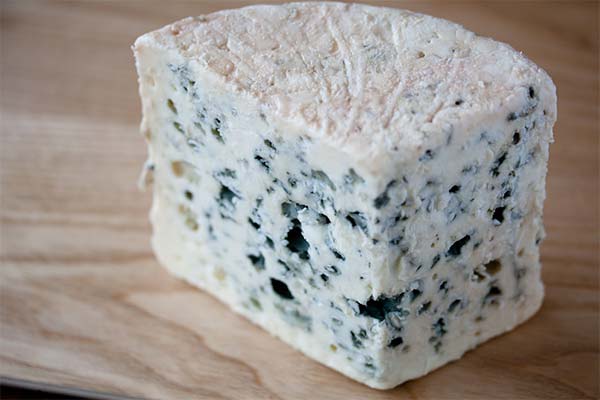
- The substances in the Penicillium roqueforti mold help the human body produce melanin. It protects the skin from the harmful effects of the active sun and reduces the risk of malignant tumors.
- The high content of phosphorus and calcium strengthens the bone skeleton. Therefore, Roquefort cheese is especially useful for children and people of advanced age.
- Regular consumption of this product reduces the risk of developing tuberculosis.
- Nutritionists recommend eating Roquefort at least twice a week in small slices for patients with gout and arthritis. The active substances in the mold have an anti-inflammatory effect and relieve pain.
- For dysbacteriosis, doctors advise eating some Roquefort cheese. He will not only create a favorable environment for the growth of beneficial bacteria, but also have a suppressive effect on the fermentation reaction in the large intestine.
- Children and adolescents are especially useful to take this product. It promotes immunity. Vitamins and minerals, which are rich in cheese, the body needs during the period of formation and growth. Therefore, it is often recommended to women during pregnancy and breastfeeding.
- The easily digestible protein helps to build muscle. Therefore, Roquefort cheese is indispensable in the menu of athletes.
- Despite its caloric content, the main fats are quickly digestible. This makes it possible to recommend the product in case of hard work, heavy physical exertion. With sleep disorders and increased anxiety, French mold cheese acts as a natural antidepressant. He normalizes the work of the nervous system.
- Amino acids and antioxidants slow down the aging process of the whole body. Beneficial effect on the skin, making it supple and fresh.
Harms and contraindications
First of all, a serious harm to health can bring individual intolerance to the components that make up the product. If there is an allergy to sheep's milk, then you should not even try Roquefort. Also, mold can cause an allergic reaction. Therefore, trying the cheese for the first time, you should limit yourself to a small piece and observe your condition.
If the dairy product is not a constant on your table, then young children should be given it with great caution. You need to strictly limit its consumption, because the lymph nodes can give a negative reaction.
In some cases, inordinate consumption of French cheese with mold causes dysbacteriosis. Mold can disrupt the composition of the stomach's microflora. Doctors believe that it is enough to eat only 50-75 grams of Roquefort cheese a day.
Gram-positive Listeria bacilli, which live in blue cheese, are absolutely safe for a healthy person. But with low immunity can develop listeriosis, which leads to damage to the liver and nervous system.
With great caution and in very limited quantities allowed to eat Roquefort people overweight. This is a caloric product, most of the composition of which is fat.
How to choose and store it correctly
Real French Roquefort cheese is available year-round. But the complicated manufacturing conditions and long maturation period make it a rather expensive product. That is why it is almost impossible to find this delicacy on the shelves of discounters. The high price provokes the appearance of fakes on the market, so it is important to know how to choose a quality cheese.
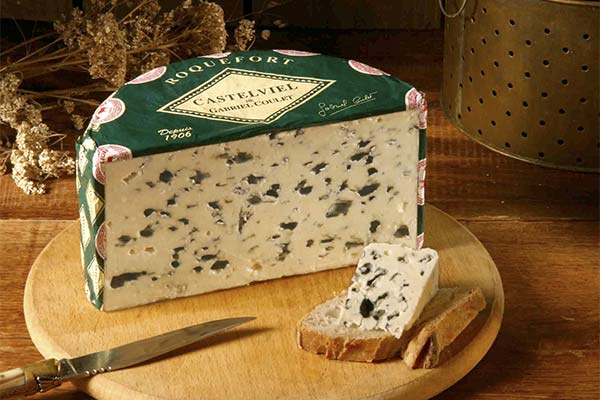
- First of all, you need to pay attention to the packaging. Real Roquefort, produced in the province of Ruerg, necessarily has a red oval seal pattern with a sheep in the center.
- The cheese should not have a crust. Inside the mass is slightly oily, white. The mold is located mainly in the eyelets located throughout the body of the product.
- If greenish veins filled almost all the space, it says that the cheese has been stored too long. It is better to refrain from buying it.
- Transparent droplets of moisture, which may appear on the surface of the cheese when you change temperature, emphasize its high quality.
- It should not crumble or flake when sliced. Not everyone in the house has a special knife for Roquefort, so you can use an ordinary cheese knife. But after each slice is cut, it must be wiped off, so as not to crush the next one.
- The smell of the product, though strong, but it should not give away sour. This indicates that it has not been stored properly and should not be eaten.
Roquefort should be put immediately in an airtight bag or refrigerator bag when you buy it. Any temperature fluctuations will shorten its shelf life. At home you should immediately place it on the bottom shelf of the refrigerator.
After opening the package, wrap the product in parchment paper, which should preferably be changed every other day. This will help maintain the necessary humidity and prevent the drying of the cheese.
So that the smell from the blue cheese with mold not permeate the other products in the refrigerator, Roquefort placed in a sealed container. In this form it can be stored for up to two months.
How and with what Roquefort is eaten
Before serving, take the product out of the refrigerator about an hour in advance and cut into segments from edge to center. The fullest flavor of Roquefort is in the slices from the very core of the cheese head. It is therefore customary to put different slices on each guest's plate. If you intend to serve it on a common plate, choose a wooden tray. In this case, the head is not sliced, and left whole. A special knife with a string for slicing is placed next to it.
This delicacy can be eaten for dessert by itself. This way you get to feel the full bouquet of flavor. A knife and fork are used. According to the rules of etiquette, eating Roquefort with your hands is not allowed.
A classic version would be eaten with rustic rye bread.
Roquefort is often accompanied by red grapes, quinces, kiwis, peaches, green apples or figs. Blue cheese is well combined with honey, nuts, dried fruits. It is worth trying Roquefort with strawberries.
What wine goes well with Roquefort?
It is customary to match blue varieties with a wine with a high tannin content. They are good to emphasize the savory taste of the delicacy.
Experts advise "Banyuls", "Porto Vintage", "Sauternes", "Barsac".
Where to buy and how much it costs
Due to the high price and low purchasing power of the Russian population, you can find French Roquefort cheese only in gastronomic boutiques or online stores. On average, their price at the end of 2021 ranges around five to six thousand rubles per kilogram.
How to cook Roquefort cheese at home
To cook at home a real Roquefort cheese is unlikely to succeed. But the product, created with your own hands, will be no less delicious and very similar to the original.
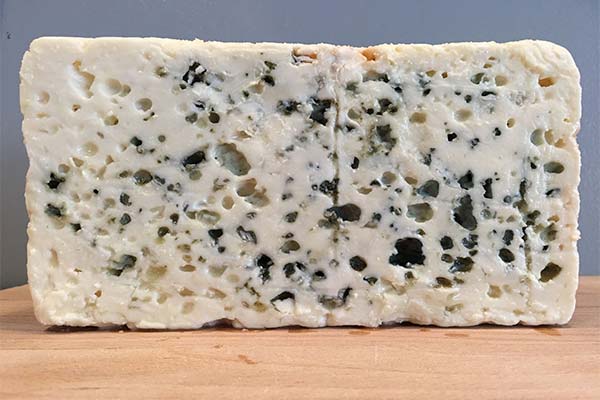
To begin with, you need to stock up on all the necessary equipment. In the process of work will be required:
- A colander and a strainer.
- A special knife for slicing the curd mass. It resembles a metal frame with stretched strings. But if you are not planning to make cheeses in large quantities, you can use a long thin knife. It should reach to the bottom of the pan.
- Measuring spoons and a beaker.
- An accurate thermometer.
- Gauze.
- Foil with parchment paper.
- A drainage mat. You can use a bamboo mat, which is used in making rolls.
For 16 liters of sheep milk you will need 1/4 teaspoon of Danisco Choozit MA 11 mesophilic starter, 1/4 teaspoon of Penicillium Roqueforti mold, 3,4 ml of 10% calcium chloride solution (you can make it yourself from granules), 4,8 ml of rennet and 2 tablespoons of salt.
Store bagged milk is not suitable for making cheese. It is pasteurized at high temperatures. The clot will not form. It is best to buy the product from a private farm and pasteurize it at home. To kill all the pathogenic bacteria it is sufficient to heat the milk to 75 ° C and after 30 seconds quickly cooled to 32 degrees.
Once the milk has cooled to the correct temperature, a mesophilic starter is added. Leave the powder to soak in moisture for 3-4 minutes, and only then gently stir the contents of the container with a slotted spoon.
In the warm water you need to pour a solution of calcium chloride (in the proportion of 3.4 ml of solution per 100 ml of water). You can use a pre-prepared 10% mixture, checking beforehand that there is no sediment in it.
The rennet is also diluted in 100 ml of water.
Pour the prepared liquid into a pot and mix all the contents of the container thoroughly. Add the mold spores diluted in water.
To form a clot, you need to maintain the temperature of the mixture at about 30 degrees Celsius for half an hour.
The resulting cheese clot is tested for breaking. Use a sharp, thin knife to make an incision and lift the top a little. The edges should be straight. If it is not, you should wait another 15-20 minutes. The ready clot is cut into cubes and allowed to stand. This is necessary to remove excess whey.
Next, the mass is kneaded for half an hour at a temperature of 30 ° C. The cubes should be transformed into an elastic grain. It should be placed in gauze or a draining bag. The cheese kernel is shaken in a good way without squeezing. In this way the rest of the whey is removed. In the final stage of drying salt is added to the curd. Moving the cheese mass into the mold, it should not be pressed or compressed. It should subside under its own weight, leaving hollow spaces inside for Penicillium Roqueforti to develop. The mold is inverted after 15 minutes.
After the future cheese has cooled to room temperature, it is transferred to a place where the air temperature is 12-15 ° C.
On day 10-12, holes are made in the product about two centimeters apart. The cheese is pierced at the top and bottom about one-third deep. A spoke or sushi sticks are used for this.
After two weeks, the blue mold should appear. To slow its growth, wrap the cheese first in parchment, and then in foil.
Keep the product at least 60 days at 10 ° C and 80% humidity. In a young cheese taste qualities will be weaker. But the longer it matures, the softer and more flavorful it becomes.
Recipes for dishes with Roquefort cheese
French blue cheese with mold can be used to prepare a variety of dishes.
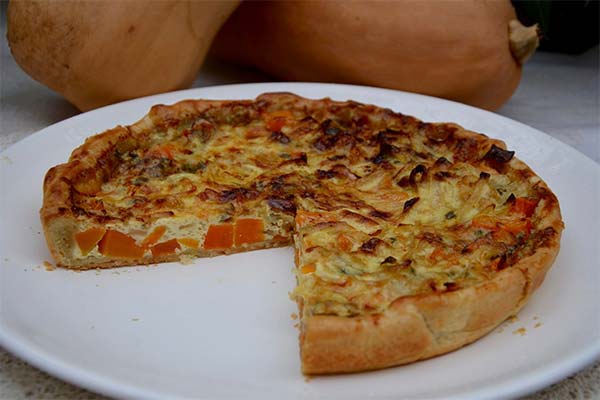
Unusual pumpkin quiche with Roquefort
The recipe is for four servings. To prepare the dough, you will need 250 grams of whole wheat flour, 125 grams of butter, one chicken egg and salt to taste. It is best to use sea salt, but ordinary salt will do.
For the filling, prepare 2 cloves of garlic, rosemary, 5 tablespoons of olive oil (you can replace it with any other oil), a medium pumpkin, 3 chicken eggs, 300 ml of milk 2.5% fat, 140 grams of Roquefort cheese, peppers, herbs, salt.
Recipe: add salt and chopped butter to the sifted dough. In a separate container mix an egg with 5 tbsp water. Pour everything into the flour. The resulting mass of knead with your hands, cover and put in the refrigerator for about 50-60 minutes. Roll out the dough. The thickness of the dough must be 3-4 cm. Grease a baking dish and put the dough on the bottom. Cover it with baking paper and put dry beans or peas in it. This is to ensure that the dough retains its shape when baked. Heat the oven to 180 ° and place the form there for 25 minutes.
Mix finely chopped garlic with chopped rosemary, vegetable oil and salt. Cut the peeled pumpkin into slices and bake on a baking tray for about 20 minutes at the same temperature. Mix milk, eggs, salt, herbs and pepper.
In the prepared form of dough put the baked pumpkin, pour the resulting mixture, sprinkle with shredded mold cheese. Put to bake in the oven for 35 minutes at the same temperature.
Roquefort salad
Need 200 grams of blue cheese, 1 cup of cream, 1 tablespoon of lemon juice, green salad, ground pepper.
Add lemon juice, pepper and cream to the mashed cheese. Mix everything until homogeneous. Put lettuce leaves on the bottom of a plate, finely chop the rest of the greens. Mix them with the cheese salad and put on the plate.
How you can substitute Roquefort cheese in this recipe
Completely replace Roquefort with some other cheese is unlikely to work. The taste of the final dish will be different than intended. Therefore, if you are preparing for the reception, it is better to experiment in advance, using different options. Then you can find a more or less acceptable substitute. As a last resort, you will have time to choose another dish.
The basic rule that should be followed is to look for a product that is closest in texture to the Roquefort. You won't get a complete match in taste, but you should look for other blue varieties first. For example, such as Dor Blue or Gorgonzola. In Russia, they have now started to produce Roquefort from cow's milk. As a standalone dish, it is noticeably different from the original, but combined with other ingredients can serve as an adequate substitute for making a complex salad.
Also, in some recipes you can try using Adygean cheese, Feta, Tofu.
Perhaps you can end up inventing a completely new dish that will please those around you just as much as the classic recipe.
Interesting Facts
- Before penicillin was invented, Roquefort cheese was often used as an anti-inflammatory by applying it to an open wound. It was thought to prevent blood poisoning and the development of gangrene. Later, scientists confirmed that the mold Penicillium roqueforti is a natural antibiotic.
- In 2012, the comic book series "Bezoboi" began to be published in Russia. One of the characters, a fallen angel, was named Roquefort by the authors. His brother was named after another famous French cheese, Beaufort.
- The French call this blue mold cheese "Monsieur Fromage" (from Fromage, which translates to cheese). This underscores their respect and love for the product.
- Cheesemakers at one time tried to make a map of French cheeses, but abandoned the task when the list exceeded 500 items. Roquefort was one of the top choices on the list.
- The famous French cheese was for a long time prohibited for importation into Australia. Local officials attributed it to the fact that the milk was not pasteurized at high temperatures before cooking. Only in 2005, after Australian officials visited the cheese dairies and looked at the caves where Roquefort matures, the cheese was recognized as "edible". Only the product made in the southern province of Ruehrg was allowed to be sold. Other varieties of blue cheese were not affected by it.
«Important: All information on this site is provided for informational purposes only. The information on this web site is for guidance only. Before applying any recommendations, consult your health care professional. health care professional. Neither the editors nor the authors are liable for any possible harm caused by materials."


